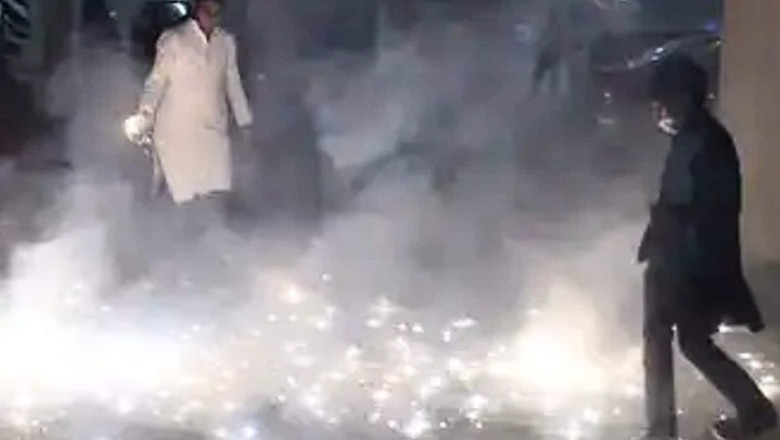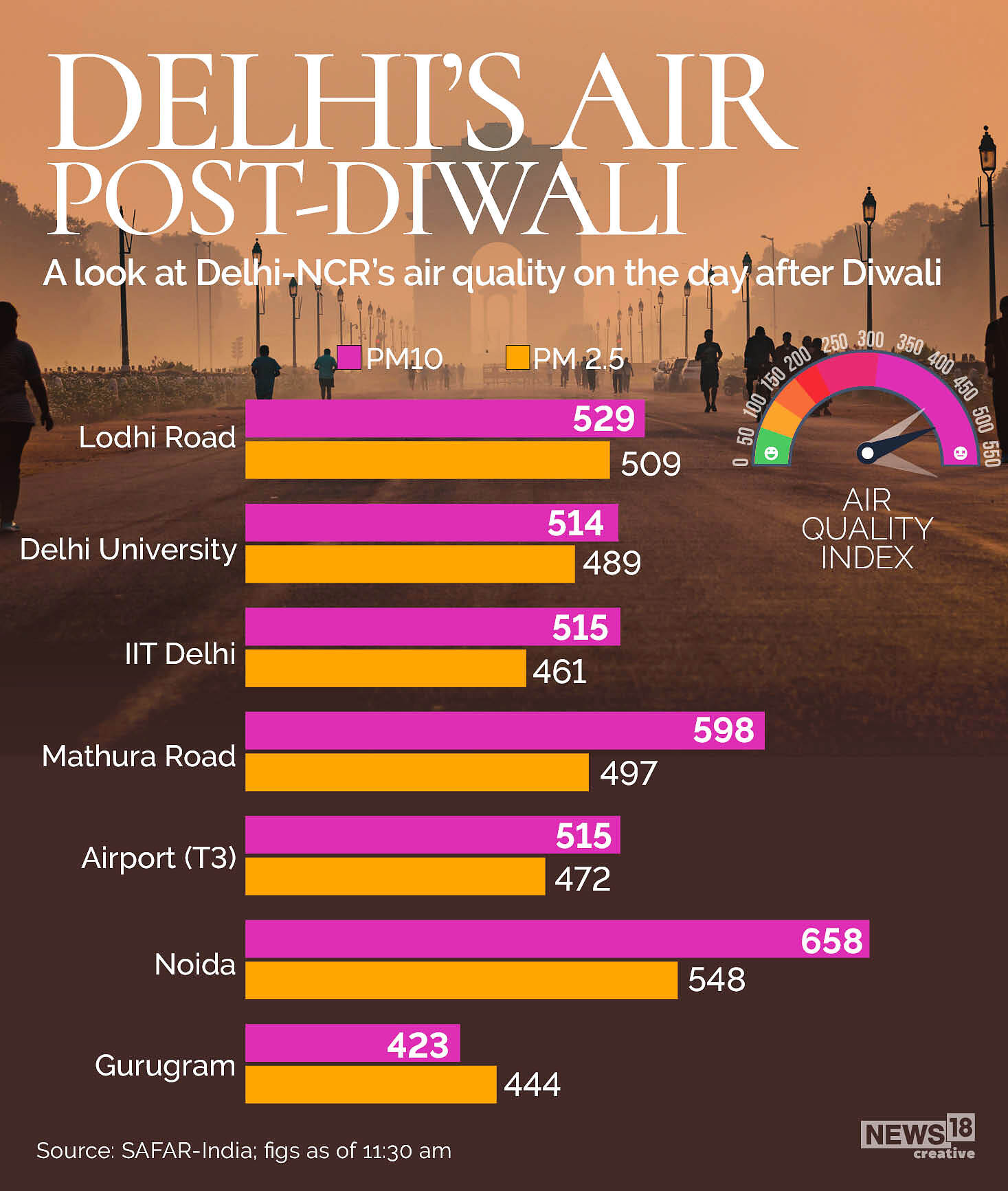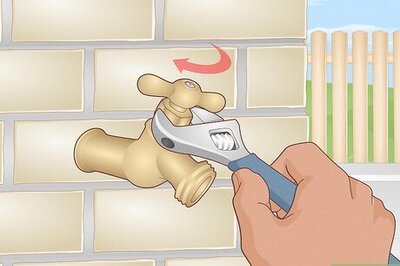
views
Despite a Supreme Court order, several appeals by the Arvind Kejriwal government and other efforts in place to keep a check on bursting of firecrackers during Diwali, several areas in the city reported violations as people burst crackers all through Thursday.
On Friday morning, Delhiites woke up to a thick blanket of smog and a worrying AQI of 617. People from several parts of the city and its suburbs complained of itchy throat and watery eyes.

A comparison of data from this year and the last few years shows that nothing much as changed about the toxic city skies around this time of the year. Here’s a look at how the capital fared a day after rules were violated on Diwali:
2017: AQI 391
All hopes of cracker-free festivities were dashed in 2017 as Delhi burst crackers will we hours of Diwali, giving way to thick haze and noise, despite a Supreme Court ban on the sale of firecrackers in the National Capital Region (NCR). The online indicators of the pollution monitoring stations in the city glowed red, indicating a ‘very poor’ air quality as the volume of ultra fine particulates PM2.5 and PM10 sharply rose from around 7 pm. The AQI was recorded at 367 a day after the festivities.
The situation was similar, if not worse, in the neighbouring regions of Delhi such as Gurgaon, Noida and Ghaziabad, where crackers were burst as usual, raising question marks on the efficacy of the administration in enforcing the apex court’s ban.
However, experts said that the air quality during Diwali was better in 2017 than in a year before that. The Air Quality Index (AQI) value this time was 319, putting it in “very poor” category, while the AQI in 2016 had touched “severe” level after recording an index value of 431.
Also Read: At 617, Delhi Breathes in ‘Hazardous’ Air Post Diwali as People Burst Crackers Despite Ban
2018: AQI 642
In 2018, Delhiites continued to burst firecrackers long after the deadline set by the Supreme Court, resulting in AQI of 302 on the night of Diwali. The court had allowed bursting of firecrackers from 8 pm to 10 pm only. It had also allowed the sale and manufacture of only “green crackers” which have a low light and sound emission and less harmful chemicals.
These rules, however, were defied and the air quality started deteriorating rapidly from 7 pm. The AQI was 281 at 7 pm and rose to 291 at 8 pm. It further deteriorated to 294 at 9 pm and 296 at 10 pm. The average AQI of 281 on Diwali deteriorated to a shocking 642 the next day 642, which falls in the “severe plus emergency” category, and remained in the “severe” category on three consecutive days.
2019: AQI 306
On the morning after Diwali in 2019, Delhi recorded an AQI of 306. The air quality remained in the “severe” category for several days afterwards, data from the Central Pollution Control Board showed. The situation was no less alarming in the National Capital Region with both Noida and Gurugram registering air quality in the “severe” category.
The AQI was 448 at Noida’s Sector 62. In Gugugram’s Vikas Sadan, the AQI stood at 403. The PM10 index, which measures the concentration of particulate matter of 10 microns diameter or less in the air, hit a shocking 408. The average AQI in the next 24 hours that followed was 337, and 368 and 400 in the next two days. The pollution levels remained in the “severe” category for three days in a row.
2020: AQI 414
The same narrative followed the next year with Delhiites once again ignoring the cracker ban. The AQI reached 414 – the worst in the city since 2016 on Diwali. The PM2.5 levels stood at 329 ug/m3 at 7 pm. The safe limit is 60 ug/m3. The PM10 level stood at 543 ug/m3 at 6 am, above the emergency threshold of 500 ug/m3, before it started decreasing. According to Central Pollution Control Board (CPCB) data, it reached 441 ug/m3 at 7 pm.
Most of the areas, including Delhi University, Pusa Road, Lodhi Road, Mathura Road, IIT-Delhi, Indira Gandhi International Airport (Terminal-3) and Ayanagar recorded air quality in the ‘severe’ category with an AQI of 479, 433, 392, 427, 398, 468 and 424, respectively.
According to some reports, the stubble burning around Diwali in 2020 accounted for 32 per cent of the city’s PM2.5 pollution, which is about 3 per cent the diameter of a human hair and can lead to premature deaths from heart and lung diseases.
In fact, taking strict measures, the Delhi Police had arrested 10 people for selling firecrackers and registered 12 cases for selling and purchase of crackers. But none of the measures seem to have put an end to the hazardous practice, as became evident on Friday.
2021: AQI 386
On Friday, Delhi’s overall air quality index was 617 at 7:55 am and entered the “hazardous” category. At around 3am, the air quality at Janpath in Delhi was in ‘hazardous’ category with PM2.5 at 655.07. According to the SAFAR, the capital’s 24-hour average air quality index (AQI) stood at 382 on Thursday, up from 314 on Wednesday. It was 303 on Tuesday and 281 on Monday.
On Thursday, residents of Lajpat Nagar in South Delhi, Burari in North Delhi, Paschim Vihar in West Delhi and Shahdara in East Delhi reported incidents of firecracker bursting as early as 7 pm, despite the blanket ban in the national capital till January 1, 2022. Several incidents of high-intensity cracker bursting were reported from Gurgaon and Faridabad despite a ban on the sale or use of all kinds of firecrackers in 14 of Haryana districts.
How Much do Firecrackers Add to Pollution?
In a study conducted by the scientists Dhananjay Ghei and Renuka Sane in 2012-17, it was revealed that Diwali leads to “a small but statistically significant rise in air pollution” in the capital.
In their report that was made public in 2018, Ghei and Sane had drawn attention to the sudden rise in the PM 2.5 particulate concentration, saying, “Diwali adds about 40 µg/m3 to PM 2.5 particulate concentration.” The number may not be very big if looked at individually, but when added to the pool of already toxic air, acts as a big menace.
Read all the Latest India News here

















Comments
0 comment